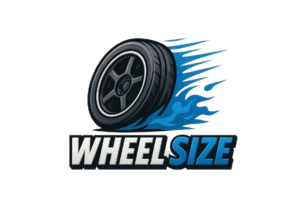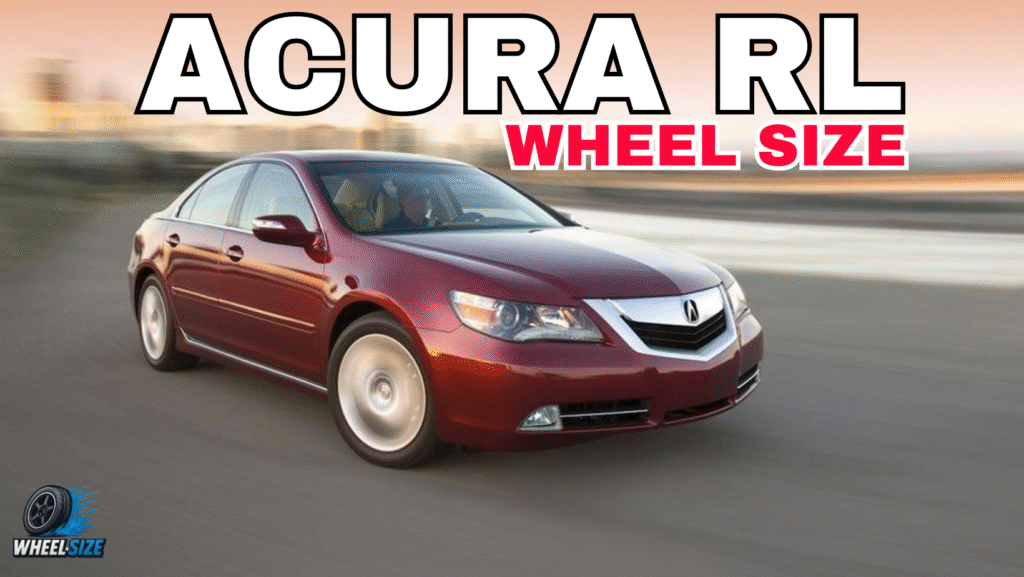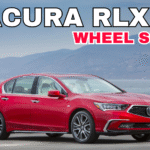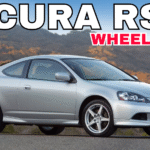When you want to customize or keep your Acura RL in good shape, the appropriate wheel fitment isn’t just about how it looks; it’s also about how well it works, how comfortable it is, and how safe it is. If you’re getting new wheels for style or to replace a broken one, you need to know the right requirements for bolt pattern, offset, rim size, and tire compatibility. There were three main types of the Acura RL, which was made from 1996 to 2013: KA9 (1996–2004), KB1 (2005–2008), and KB2 (2009–2013).
Different wheel standards are used for each iteration to fit the car’s drivetrain and design. If you get these wrong, your brakes might not work right, or you might rub against anything. A set of wheels that fits properly, on the other hand, can make your RL handle better, ride better, and look new on the road.
This guide will help you understand the wheel fitment specifications for all Acura RL generations so you can make smart choices about factory replacements or aftermarket enhancements. Let’s get started with the basics.
Understanding Wheel Fitment Guide
It’s crucial to know the basic words used in wheel fitment before getting into specific years and models. Some of these are bolt pattern, rim size, offset, hub bore, and tire size. Each of these affects how well a wheel fits and works on your car.
- Bolt Pattern: It tells you how many lug holes there are and how far apart they are. The wheel won’t fit if the bolt pattern doesn’t match.
- Rim Size: This tells you how wide and tall the wheel is. Larger diameters can make the car easier to drive, but they might make the ride less comfortable.
- Offset tells you how much the wheel mounting surface is from the centerline of the wheel. If the offset is wrong, it can cause problems with clearance.
- Hub Bore: This is the hole in the middle of the wheel that fits over the hub of the car. A perfect fit means a ride without vibrations.
- Tire Size: tells you how wide the tire is, how high the sidewall is, and what size wheels it will fit.
If you know these essentials, any wheel update will make your car better instead of worse.
Read ABout: Acura RLX Wheel Fitment Guide
Acura RL KA9 [1996–2004] Wheel Fitment Guide
The first-generation Acura RL, also known as the KA9, took the place of the famous Acura Legend in 1996. The KA9 was designed with refinement in mind, therefore it focused on smooth cruising and luxury instead of aggressive performance. The way the wheels were set up was in line with that idea, with small sizes that made them more comfortable and reliable. The bolt pattern is 5×114.3, which was common for a lot of Honda and Acura cars at the time. The hub bore is 64.1mm, and the OEM rims were usually between 15 and 16 inches, depending on the trim.
The offset range for this generation is between +40 and +45 mm. This maintains the wheel securely tucked beneath the fender without jutting out. Most versions had tires like 215/60R16 or 225/55R16, which were a nice mix of sidewall comfort and tread breadth. You can make changes to the car after you buy it, but you shouldn’t go too far. For this chassis, 18″ wheels are normally the most you can get without impacting ride quality or clearance.
| Year | Center Bore | Bolt Pattern | Lug Nut Thread | OEM Tire Size | OEM Rim Size | OEM Offset Range (mm) | Aftermarket Wheel Size Range |
| 1996 | 64.1 mm | 5×114.3 | M12 x 1.5 | 215/60R16 94V | 6.5JJx16 ET65 | 63 – 67 | 16-18 |
| 1997 | 64.1 mm | 5×114.3 | M12 x 1.5 | 215/60R16 94V | 7JJx16 ET65 | 63 – 67 | 16-18 |
| 1998 | 64.1 mm | 5×114.3 | M12 x 1.5 | 225/55R16 94V | 7JJx16 ET65 | 63 – 67 | 16-18 |
| 1999 | 64.1 mm | 5×114.3 | M12 x 1.5 | 235/50R17 96V | 7.5Jx17 ET55 | 63 – 67 | 16-18 |
| 2000 | 64.1 mm | 5×114.3 | M12 x 1.5 | 215/60R16 94V | 7JJx16 ET65 | 63 – 67 | 16-18 |
| 2001 | 64.1 mm | 5×114.3 | M12 x 1.5 | 225/55R16 94V | 7JJx16 ET65 | 63 – 67 | 16-18 |
| 2002 | 64.1 mm | 5×114.3 | M12 x 1.5 | 235/50R17 96V | 7.5Jx17 ET55 | 63 – 67 | 16-18 |
| 2003 | 64.1 mm | 5×114.3 | M12 x 1.5 | 235/50R17 96V | 7.5Jx17 ET55 | 63 – 67 | 16-18 |
| 2004 | 64.1 mm | 5×114.3 | M12 x 1.5 | 235/50R17 96V | 7.5Jx17 ET55 | 63 – 67 | 16-18 |
Bolt Pattern, Offset, and Center Bore
The KA9 has a 5×114.3 bolt pattern, which works well with wheels that aren’t made by the same company. This five-lug setup evenly distributes weight and holds things in place around the wheel hub. The offset range of +40 to +45mm is critical because if the offset is too low, the wheels will stick out, which can cause them to scrape on the fender. The center bore is 64.1mm, which is the same size as Honda’s standard hub at the time. If you get wheels with a bigger bore, make sure to utilize hub-centric rings to stop vibrations when you go faster. If you stick to these specs, the wheels will fit snugly and the ride quality will stay the same as it was when it was new.
Factory Wheel Size and Tire Specs
OEM wheels for the KA9 generation were made to be comfortable and good for lengthy trips. Most of the time, the manufacturer built up cars with 15- or 16-inch rims and tires that were 215/60R16 or 225/55R16. These gave the sidewalls a lot of cushion, which made the ride smooth over bumps and bad roads. The width of the tread also provides enough grip without making it hard to roll. These diameters may seem modest by today’s standards, but they were just right for the KA9’s suspension and brakes. If you’re thinking about getting new tires, it’s better to keep the total diameter near to what the factory recommends so that your speedometer and ABS sensors don’t get messed up.
Recommended Aftermarket Fitment
Most KA9 owners choose 17- or 18-inch wheels for a small modification that makes the car look better without making it less comfortable. The best fitment is 18×7.5 or 18×8 wheels with a +42mm offset and 235/45R18 tires. This mix fills out the wheel wells better than standard without causing any problems with clearance. The KA9 has front-wheel drive, thus a square arrangement (all four corners have the same wheel and tire size) is optimal for even tire wear and easier rotations. Don’t use wheels that are too wide or have deep lips because the suspension geometry wasn’t made for aggressive stance setups.
Acura RL KB1 [2005–2008] Wheel Fitment Guide
The second version of the Acura RL, called KB1, came out with better technology and a focus on performance. This was notably true with the introduction of SH-AWD (Super Handling All-Wheel Drive). The new drivetrain combination also included revised wheel specs to complement the more sporty look. The bolt pattern changed to 5×120, which is less prevalent in Honda cars but is the same as in performance brands like BMW. The hub bore stayed at 64.1mm, and the OEM wheels came in diameters from 17 to 18 inches, depending on the trim and year.
The offset range is a little higher than the last generation, between +45 and +55mm. This is because the suspension and all-wheel drive parts are more modern. 245/50R17 and 245/45R18 are two common tire sizes that give you better traction and cornering ability. If you’re going to upgrade, you’ll find that 19″ wheels are a fantastic mix of athletic looks and easy driving. But to keep SH-AWD working, you should stay away from staggered arrangements.
| Year | Center Bore | Bolt Pattern | Lug Nut Thread | OEM Tire Size | OEM Rim Size | OEM Offset Range (mm) | Tire Pressure (Front / Rear, bar) | Aftermarket Wheel Size Range |
| 2005 | 64.1 mm | 5×120 | M14 x 1.5 | 245/50R17 98V | 8Jx17 ET55 | 53 – 57 | 2.3 / 2.3 | 17-20” |
| 2006 | 64.1 mm | 5×120 | M14 x 1.5 | 245/45R18 96V | 8Jx18 ET55 | 53 – 57 | 2.3 / 2.3 | 17-20” |
| 2007 | 64.1 mm | 5×120 | M14 x 1.5 | 245/40ZR19 98W | 8.5Jx19 ET50 | 53 – 57 | 2.3 / 2.3 | 17-20” |
| 2007 | 64.1 mm | 5×120 | M14 x 1.5 | 245/40ZR19 98W | 8.5Jx19 ET50 | 53 – 57 | 2.3 / 2.3 | 17-20” |
Bolt Pattern, Offset, and Center Bore
The KB1 has a bolt pattern of 5×120, which is different from the one before it. This means that it won’t work with as many aftermarket parts unless you have wheels from certain brands or manufacturers that make this spec. The offset is between +45 and +55mm, which lets the wheels fit more tightly with the car’s body and suspension. If you keep the offset in this range, the wheels will have enough room to move and the SH-AWD performance will stay balanced. The hub bore stays at 64.1mm, which is the same as for Honda and Acura vehicles. Hub-centric rings are necessary for a safe and vibration-free ride if you use aftermarket wheels with a larger bore.
Factory Wheel Size and Tire Specs
The KB1 came with 17×8 or 18×8 wheels, depending on the trim level. These came with 245/50R17 or 245/45R18 tires, which gave a fantastic balance between comfort and performance. These tire widths provided the car better grip than the KA9, especially when it was wet. The 18-inch versions had a smaller sidewall, which made the car feel sportier. The width and profile of the tires also helped the SH-AWD system send power more effectively. These sizes are perfect if you want to keep items stock. They work well with the car’s suspension adjustment and keep the ride quality at its best.
Acura RL KB2 [2009–2013] Wheel Fitment Guide
The last iteration of the Acura RL, called KB2, had better appearance and a smoother ride. The KB2’s dramatic “power plenum” grille and better lighting made it stand out, and it still had the SH-AWD system that made the second generation so great. The stock wheels on this model were 18 inches in diameter and had a 5×120 bolt pattern, a 64.1mm hub bore, and an offset range of +45 to +55mm.
The stock tire size was 245/45R18, which was a good size for comfort, fuel efficiency, and traction. The KB2 fit the same as the KB1, but it came with more aggressive look from the factory, which made it a popular choice for subtle aftermarket improvements. To make the sedan look more modern, many owners switch to 19″ or 20″ wheels. However, it’s crucial to keep the right offset and overall diameter to keep the SH-AWD system safe and the alignment proper.
Bolt Pattern, Offset, and Center Bore
The KB2 has the same 5×120 bolt pattern and 64.1mm hub bore as the KB1, which makes it easy to use wheels from both generations. The offset range of +45 to +55mm makes sure the wheels lie flat without sticking out too far, which could cause problems with clearance. Always utilize hub-centric rings if you choose wheels with a varied hub bore. This will keep the tires from vibrating or wearing unevenly. It’s especially vital to stick to the right bolt pattern and offset on SH-AWD models because even tiny differences in fitment can change how the car handles and how well it balances.
Factory Wheel Size and Tire Specs
The KB2 came with 18×8 wheels and 245/45R18 tires, which were the right height and width for the sidewalls and tread. This configuration made the ride feel smooth and stable while yet feeling like a luxury car. If you want to upgrade, it’s crucial to keep close to this overall diameter because the SH-AWD system and speed sensors need speeds that stay the same. The default size looks good, but a lot of owners upgrade to 19″ wheels to give their car a more grounded stance without sacrificing comfort.
Recommended Aftermarket Fitment
19×8.5 or 20×9 wheels are the best options for updating your KB2’s wheels. To keep the right rolling diameter, use 245/40R19 or 245/35R20 tires with them. To avoid rubbing or bad alignment, the offset should stay between +45 and +50mm. Don’t use staggered setups because they can mess with SH-AWD. The KB2’s sleek look goes well with brands that provide polished, concave, or split-spoke finishes. You won’t have to roll the fenders or change the suspension if you maintain the width under 9.5 inches for everyday use.
Things to Consider Before Upgrading Acura RL Wheels
Changing your Acura RL’s wheels can improve its safety, comfort, and power. The first thing to think about is whether the fit is right. Make sure that the replacement wheels fit your bolt pattern, offset, hub bore, and rim width. If any of these are out of alignment, it might cause vibrations, friction, or even make handling worse.
The size of the tires is also very important. Pick tires that keep the total diameter close to what the factory says it should be. If your wheels are 20 inches, check sure the sidewall height is right so that it doesn’t change your speedometer or transmission gearing.
SH-AWD is sensitive to unequal tire widths or wheel diameters on KB1 and KB2 models, hence staggered installations are not recommended. Finally, consider about how the new wheels will work with your suspension. Wheels that are too wide or have too low of an offset can rub against things, and you may need to roll the fenders or change the camber. A smart improvement makes your ride better, so always do your research before you buy.
Best Wheel Brands for Acura RL Owners
It’s not only about how your Acura RL wheels appear when you choose a brand. It’s all about style, safety, and strength. Some of the greatest wheel brands that get the balance just right are
- Enkei – Known for their strength-to-weight ratio and stylish finishes.
- TSW – Offers clean, modern designs with correct offset and bore options for Acuras.
- Konig – Budget-friendly yet performance-focused, ideal for subtle upgrades.
- Vossen – Premium wheels with aggressive styling, perfect for KB2 RLs.
- BBS – A classic high-end choice that brings European flair and trusted engineering.
Before you buy, make sure to check the bolt pattern (5×114.3 or 5×120 depending on the generation), the center bore (64.1mm), and the right offset. Buying from well-known brands also makes sure you get construction that has been tested for safety, a good warranty, and a wide range of sizes and finishes. Pick a brand that fits your driving style, whether you drive every day or just on the weekends.
Conclusion
If you want to update or replace your car, you need to know how to install the wheels, whether you have a classic KA9 or a modern KB2. Every little thing about your RL, from the bolt pattern to the offset, hub bore, rim size, and tire size, affects how it looks, drives, and handles the road.
Every generation has its own fitting profile, and following those requirements will help you keep the exquisite ride quality and performance that Acura wanted. A well-chosen wheel arrangement can make your RL look and handle better without putting your safety at risk if you plan to go aftermarket.
Take the time to measure, compare, and talk to experts if you need to. Your Acura RL deserves nothing less than a perfect fit.



